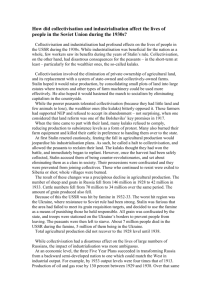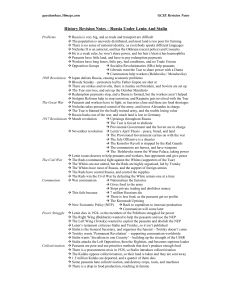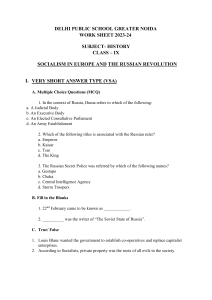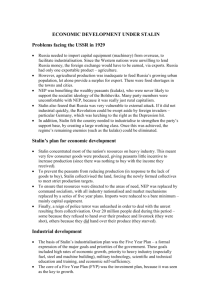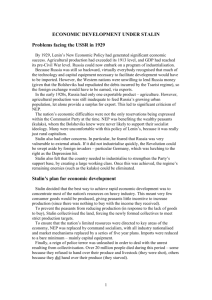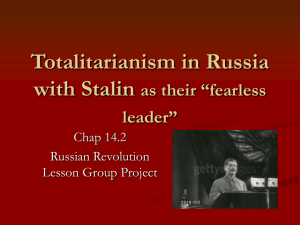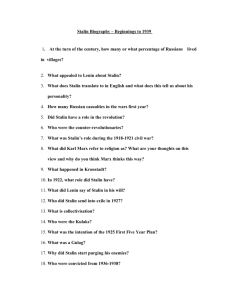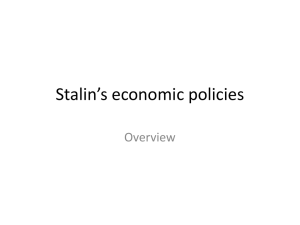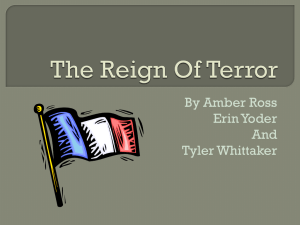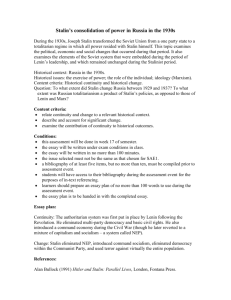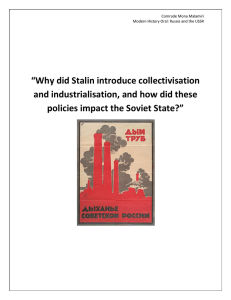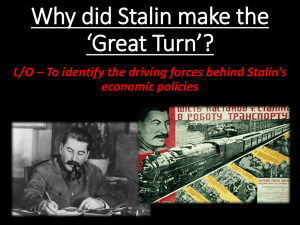04 Stalin
advertisement
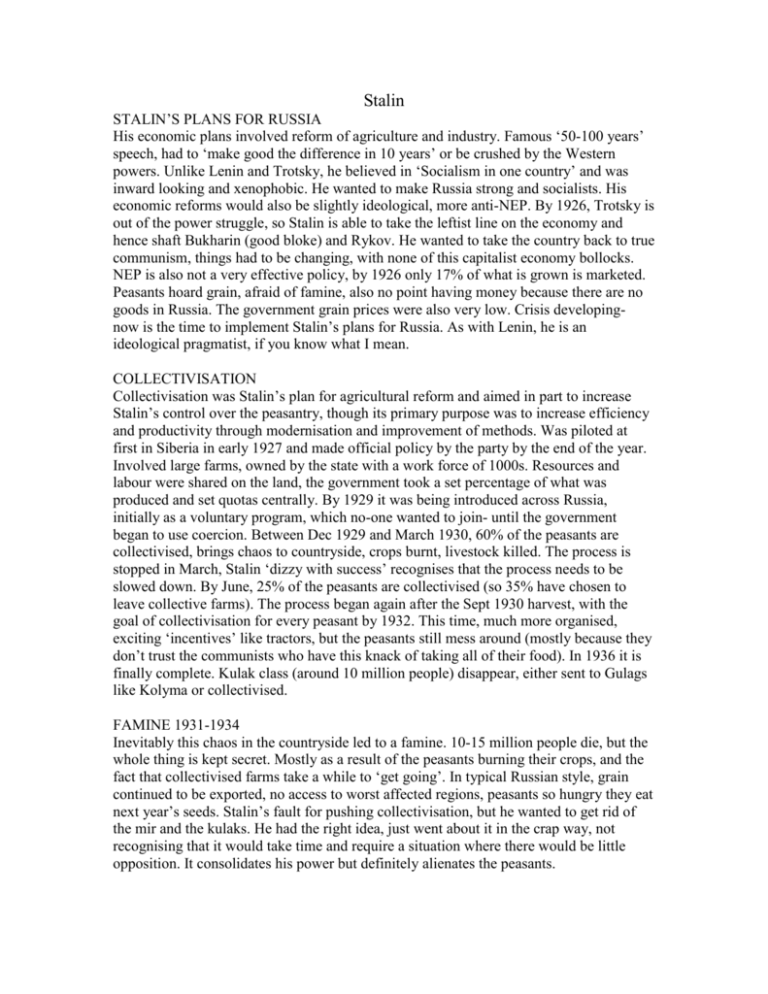
Stalin STALIN’S PLANS FOR RUSSIA His economic plans involved reform of agriculture and industry. Famous ‘50-100 years’ speech, had to ‘make good the difference in 10 years’ or be crushed by the Western powers. Unlike Lenin and Trotsky, he believed in ‘Socialism in one country’ and was inward looking and xenophobic. He wanted to make Russia strong and socialists. His economic reforms would also be slightly ideological, more anti-NEP. By 1926, Trotsky is out of the power struggle, so Stalin is able to take the leftist line on the economy and hence shaft Bukharin (good bloke) and Rykov. He wanted to take the country back to true communism, things had to be changing, with none of this capitalist economy bollocks. NEP is also not a very effective policy, by 1926 only 17% of what is grown is marketed. Peasants hoard grain, afraid of famine, also no point having money because there are no goods in Russia. The government grain prices were also very low. Crisis developingnow is the time to implement Stalin’s plans for Russia. As with Lenin, he is an ideological pragmatist, if you know what I mean. COLLECTIVISATION Collectivisation was Stalin’s plan for agricultural reform and aimed in part to increase Stalin’s control over the peasantry, though its primary purpose was to increase efficiency and productivity through modernisation and improvement of methods. Was piloted at first in Siberia in early 1927 and made official policy by the party by the end of the year. Involved large farms, owned by the state with a work force of 1000s. Resources and labour were shared on the land, the government took a set percentage of what was produced and set quotas centrally. By 1929 it was being introduced across Russia, initially as a voluntary program, which no-one wanted to join- until the government began to use coercion. Between Dec 1929 and March 1930, 60% of the peasants are collectivised, brings chaos to countryside, crops burnt, livestock killed. The process is stopped in March, Stalin ‘dizzy with success’ recognises that the process needs to be slowed down. By June, 25% of the peasants are collectivised (so 35% have chosen to leave collective farms). The process began again after the Sept 1930 harvest, with the goal of collectivisation for every peasant by 1932. This time, much more organised, exciting ‘incentives’ like tractors, but the peasants still mess around (mostly because they don’t trust the communists who have this knack of taking all of their food). In 1936 it is finally complete. Kulak class (around 10 million people) disappear, either sent to Gulags like Kolyma or collectivised. FAMINE 1931-1934 Inevitably this chaos in the countryside led to a famine. 10-15 million people die, but the whole thing is kept secret. Mostly as a result of the peasants burning their crops, and the fact that collectivised farms take a while to ‘get going’. In typical Russian style, grain continued to be exported, no access to worst affected regions, peasants so hungry they eat next year’s seeds. Stalin’s fault for pushing collectivisation, but he wanted to get rid of the mir and the kulaks. He had the right idea, just went about it in the crap way, not recognising that it would take time and require a situation where there would be little opposition. It consolidates his power but definitely alienates the peasants. THE FIVE YEAR PLANS The five year plans were implemented to help Russia to rapidly industrialize, hopefully with more success than they had last time that was tried. AIMS: An abandonment of the NEP, not like Bukharin’s ideas of unforced economy, was a break from the right. Had to be rapid and forced industrialization controlled centrally. Wanted an economy that could compare to that of Western nations in 10 years. Tool for it was Gosplan, central planning agency set up in 1921- national quotas which filter down to the local level. THE FIRST FIVE YEAR PLAN: Ran from 1928 to December 1932. Main emphasis was on infrastructure and the production of energy and construction materials, at an envisaged rate of increase of 20%. Not all quotas were reached, but there were significant increases in production in all areas. Machinery output increased X4, oil production X2, electrical output by 250%, 17 new blast furnaces. Some showpieces, Dnieprostoi Dam, and iron and steel production centres at Magniotogorsk and Kuznetsk. Laid foundations for second five year plan. Some quota shortfalls, (Steel, iron, heavy metallurgy and consumer goods suffering the worst setbacks). Also kinda like a ‘peasant buying a gramophone not a cow’- although the showpieces were very nice, they weren’t exactly all that practical. Possibly a little too hard and fast. THE SECOND FIVE YEAR PLAN: Ran from 1933 to 1937. Had a lower annual target of 14% and was designed to build on the successes of the first five year plan with a more skilled workforce. Focused again on heavy industry, metallurgical resources (Pb, Zn, Ni, Sn) and communications. Much better quality and less waste than first five year plan, more showpieces, Moscow-Volga canal and Moscow metro. Some quota shortfalls again, some administrative inefficiency and deterioration of diplomatic situation leading to spiraling military expenditure all slowed the developments. Military expenditure was 3.4% of gov’s total expenditure in 33, 16.1% by 1936 and 32.6% by 1940.
